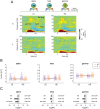Temporal-spectral signaling of sensory information and expectations in the cerebral processing of pain
- PMID: 34983852
- PMCID: PMC8740684
- DOI: 10.1073/pnas.2116616119
Temporal-spectral signaling of sensory information and expectations in the cerebral processing of pain
Abstract
The perception of pain is shaped by somatosensory information about threat. However, pain is also influenced by an individual's expectations. Such expectations can result in clinically relevant modulations and abnormalities of pain. In the brain, sensory information, expectations (predictions), and discrepancies thereof (prediction errors) are signaled by an extended network of brain areas which generate evoked potentials and oscillatory responses at different latencies and frequencies. However, a comprehensive picture of how evoked and oscillatory brain responses signal sensory information, predictions, and prediction errors in the processing of pain is lacking so far. Here, we therefore applied brief painful stimuli to 48 healthy human participants and independently modulated sensory information (stimulus intensity) and expectations of pain intensity while measuring brain activity using electroencephalography (EEG). Pain ratings confirmed that pain intensity was shaped by both sensory information and expectations. In contrast, Bayesian analyses revealed that stimulus-induced EEG responses at different latencies (the N1, N2, and P2 components) and frequencies (alpha, beta, and gamma oscillations) were shaped by sensory information but not by expectations. Expectations, however, shaped alpha and beta oscillations before the painful stimuli. These findings indicate that commonly analyzed EEG responses to painful stimuli are more involved in signaling sensory information than in signaling expectations or mismatches of sensory information and expectations. Moreover, they indicate that the effects of expectations on pain are served by brain mechanisms which differ from those conveying effects of sensory information on pain.
Keywords: brain; electroencephalography; oscillations; pain; predictive coding.
Copyright © 2021 the Author(s). Published by PNAS.
Conflict of interest statement
The authors declare no competing interest.
Figures






Similar articles
-
Local brain oscillations and interregional connectivity differentially serve sensory and expectation effects on pain.Sci Adv. 2023 Apr 21;9(16):eadd7572. doi: 10.1126/sciadv.add7572. Epub 2023 Apr 19. Sci Adv. 2023. PMID: 37075123 Free PMC article.
-
Operculoinsular cortex encodes pain intensity at the earliest stages of cortical processing as indicated by amplitude of laser-evoked potentials in humans.Neuroscience. 2005;131(1):199-208. doi: 10.1016/j.neuroscience.2004.10.035. Neuroscience. 2005. PMID: 15680703
-
Differential neurophysiological correlates of bottom-up and top-down modulations of pain.Pain. 2015 Feb;156(2):289-296. doi: 10.1097/01.j.pain.0000460309.94442.44. Pain. 2015. PMID: 25599450 Clinical Trial.
-
Pain Related Cortical Oscillations: Methodological Advances and Potential Applications.Front Comput Neurosci. 2016 Feb 4;10:9. doi: 10.3389/fncom.2016.00009. eCollection 2016. Front Comput Neurosci. 2016. PMID: 26869915 Free PMC article. Review.
-
Electroencephalography During Nociceptive Stimulation in Chronic Pain Patients: A Systematic Review.Pain Med. 2020 Dec 25;21(12):3413-3427. doi: 10.1093/pm/pnaa131. Pain Med. 2020. PMID: 32488229
Cited by
-
Temporal changes in cortical sensory processing during the transition from acute to chronic low back pain.Pain Rep. 2025 Apr 24;10(3):e1269. doi: 10.1097/PR9.0000000000001269. eCollection 2025 Jun. Pain Rep. 2025. PMID: 40291384 Free PMC article.
-
Thermosensory predictive coding underpins an illusion of pain.Sci Adv. 2025 Mar 14;11(11):eadq0261. doi: 10.1126/sciadv.adq0261. Epub 2025 Mar 12. Sci Adv. 2025. PMID: 40073134 Free PMC article.
-
AQMFB-DWT: A Preprocessing Technique for Removing Blink Artifacts Before Extracting Pain-evoked Potential EEG.Neurosci Bull. 2025 Jun 20. doi: 10.1007/s12264-025-01425-0. Online ahead of print. Neurosci Bull. 2025. PMID: 40540153
-
Agency affects pain inference through prior shift as opposed to likelihood precision modulation in a Bayesian pain model.Neuron. 2023 Apr 5;111(7):1136-1151.e7. doi: 10.1016/j.neuron.2023.01.002. Epub 2023 Feb 1. Neuron. 2023. PMID: 36731468 Free PMC article.
-
Cue-based modulation of pain stimulus expectation: do ongoing oscillations reflect changes in pain perception? A registered report.R Soc Open Sci. 2024 Jun 19;11(6):240626. doi: 10.1098/rsos.240626. eCollection 2024 Jun. R Soc Open Sci. 2024. PMID: 39100172 Free PMC article.
References
-
- Atlas L. Y., Wager T. D., How expectations shape pain. Neurosci. Lett. 520, 140–148 (2012). - PubMed
-
- Fields H. L., How expectations influence pain. Pain 159 (suppl. 1), S3–S10 (2018). - PubMed
-
- Enck P., Bingel U., Schedlowski M., Rief W., The placebo response in medicine: Minimize, maximize or personalize? Nat. Rev. Drug Discov. 12, 191–204 (2013). - PubMed
Publication types
MeSH terms
LinkOut - more resources
Full Text Sources
Medical

